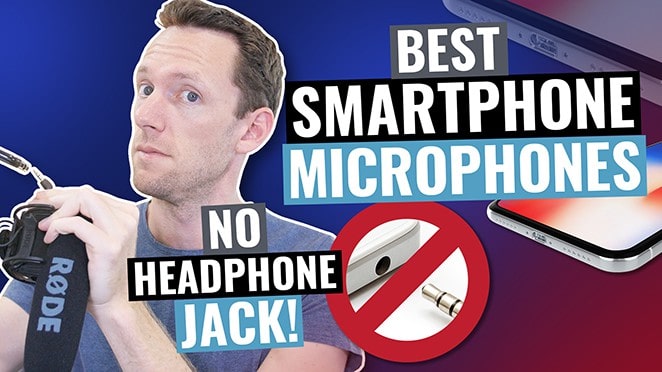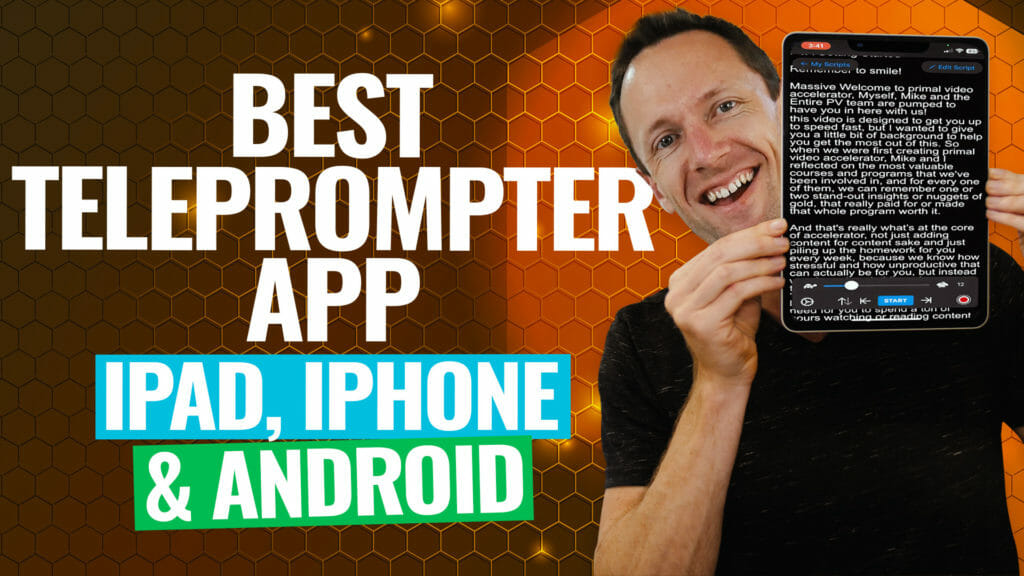ConvertKit and ActiveCampaign are both frequently mentioned in Best Email Marketing Software roundups.
They’re two of the most popular email marketing tools available right now. But how do they compare side by side?
ConvertKit vs ActiveCampaign Overview
ConvertKit positions itself as the email marketing platform for creators. It allows coaches, authors, podcasters and musicians to easily share their content and build a following.
But ConvertKit’s features aren’t just great for creators. This platform could suit a wide range of business owners – especially those who want to take advantage of its extremely easy to use interface and impressive ecommerce features.
ActiveCampaign is known as one of the top email marketing tools for automations. It’s seriously powerful.
It also has great built-in CRM, testing and reporting features. These tools make it possible to optimize your marketing campaigns for maximum results.
So which one is right for you?
Both platforms have their own strengths and weaknesses. Which is why we’ve broken this review down into the key features you need to consider when choosing the right email marketing service.
Then in each section we’ll provide a detailed comparison of the software so you can decide what’s most important for you.
Feel free to jump to the sections that are most relevant to your business.
Important: When available, we use affiliate links and may earn a commission!
Key email marketing features/aspects we’ll compare:
- Templates & Email Builder
- Marketing Automation
- Segmentation
- Contacts
- A/B Testing
- Forms & Landing Pages
- Ecommerce
- Integrations
- Reporting & Analytics
- Deliverability
- Other Noteworthy Features
- Customer Support
- Ease Of Use
- Pricing ($USD/monthly)
- Reviewer’s Recommendation
Let’s dive in.
Templates & Email Builder Comparison
The templates and email builder are an important factor in choosing an email marketing tool. You don’t want to be stuck tweaking an unappealing email template using a clunky builder.
The email builder will be assessed based on how flexible it is and how seamlessly it allows you to build out email campaigns. We’ll also look at the quality and customizability of the email templates inside these email marketing services.
ConvertKit Templates & Email Builder Review
ConvertKit’s visual editor is incredibly quick to use but it allows for minimal customization or flexibility. There’s no drag and drop editor, and you can’t easily move things around.

If you just want to create basic or text-only emails, you’ll be able to get the job done super easily. The text-only template feels like writing a work email – great for a personalized email effect.
However, the email builder is missing a few of the more advanced features. For example, there are two tools that allow you to really customize and personalize your email campaigns: the ability to hide content on mobile devices and conditional content.
Conditional content allows you to hide or display content for certain contacts based on their specific custom fields or tags. Unfortunately ConvertKit doesn’t support hiding content on mobile devices and conditional content is only possible with a workaround (using liquid code).

Saved blocks are possible using the Snippets feature but you have to go into a separate section to create it – it’s not an overly quick process to set up.
There are 9 very basic email templates. The focus is on text but a couple have built-in visuals.
Unsplash is integrated so you have access to a large, free stock image library.
There’s also a HTML editor which allows you to get more flexibility in your email designs.
Learn more about ConvertKit’s email builder here.

ActiveCampaign Templates & Email Builder Review
ActiveCampaign’s visual editor offers a ton of flexibility. They recently released a new email editor called the Email Designer.
It has a drag and drop editor as well as the ability to add different column structures into your email. This editor is great to use and is definitely a step up from their original email builder, the Classic Builder.
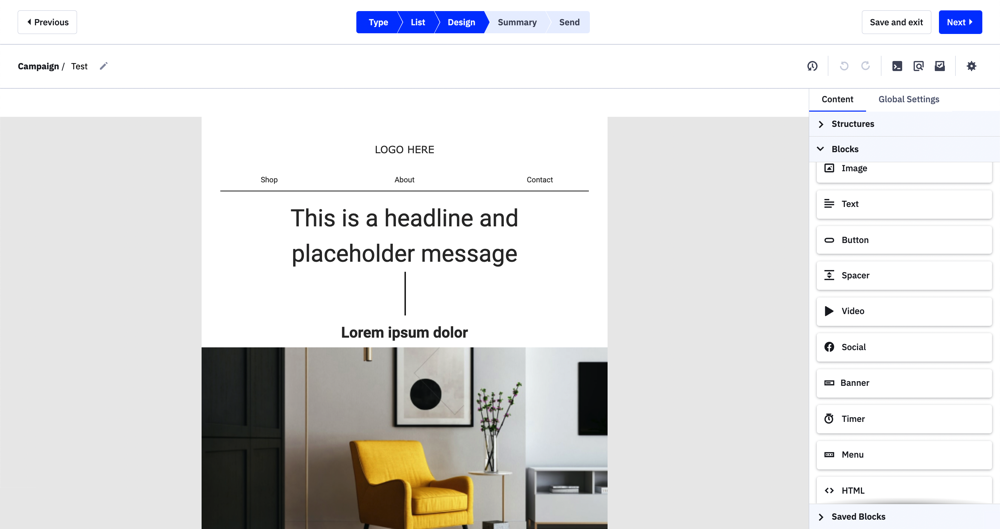
ActiveCampaigns’s Classic Builder offers a ton more customization and features than ConvertKit, but it isn’t as seamless as AC’s new Email Builder.
The benefit of AC’s Classic Builder is that it supports A/B testing and conditional content, while their new email builder doesn’t currently support those features. ActiveCampaign has said they will be added to the new builder soon though.
It’s quick and easy to hide elements on mobile or desktop and conditional content is supported.
Custom merge tags are a super powerful feature. It allows you to insert personalized content across multiple email campaigns or automations and edit that content centrally without having to manually update it everywhere you’ve used it. These are also supported.
Click here to learn more about ActiveCampaign’s custom merge tags.
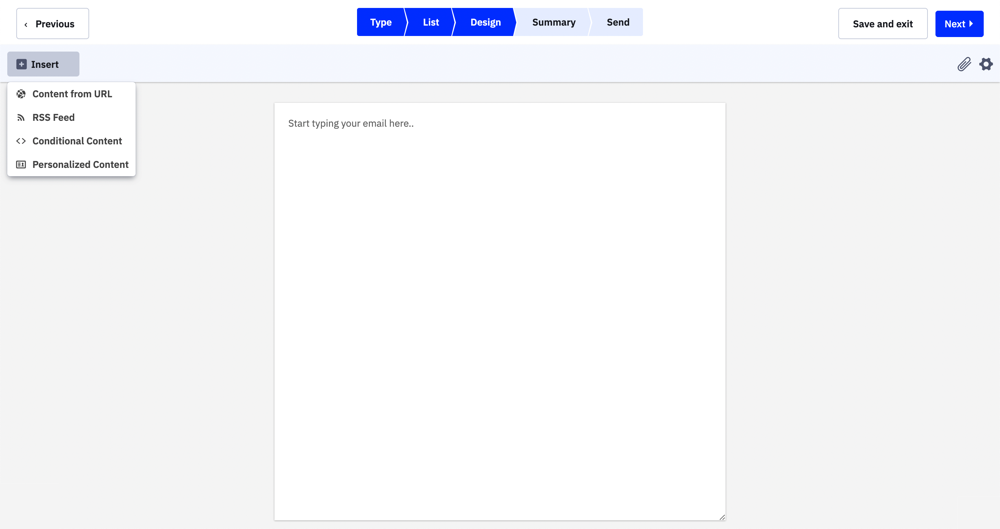
When it comes to creating text-only emails, the process is a bit more time-consuming than ConvertKit. The general email campaign section is kind of clunky and the load times are a bit slower when you’re setting up the broadcast. It doesn’t feel like a snappy process.
There are over 125 email templates with a huge range of basic and designed options available.
There’s no stock image library but some of the templates contain stock images you can use.
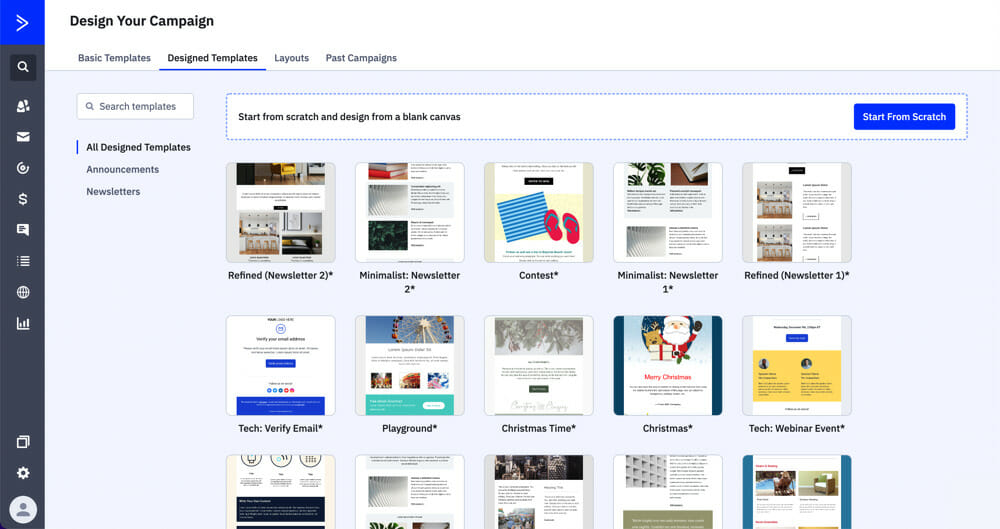
The Verdict
If you want to send basic, text-based emails then ConvertKit will allow you to do so really quickly and easily.
If you plan on spending a bit more time creating highly visual or customized emails, then ActiveCampaign will give you a lot more options and control without the need to resort to custom code.
Marketing Automation Comparison
Automating your email marketing campaigns is a great way to grow your business. Each email marketing platform takes a different approach to this and has different marketing automation capabilities.
We’ll assess a range of aspects including how simple it is to create basic and advanced marketing automations on each platform.
ConvertKit Marketing Automation Review
To send a basic sequence of emails triggered by an event (e.g. a new opt-in), ConvertKit has a built-in sequence feature. This is a separate builder that makes it really easy to build out sequences.
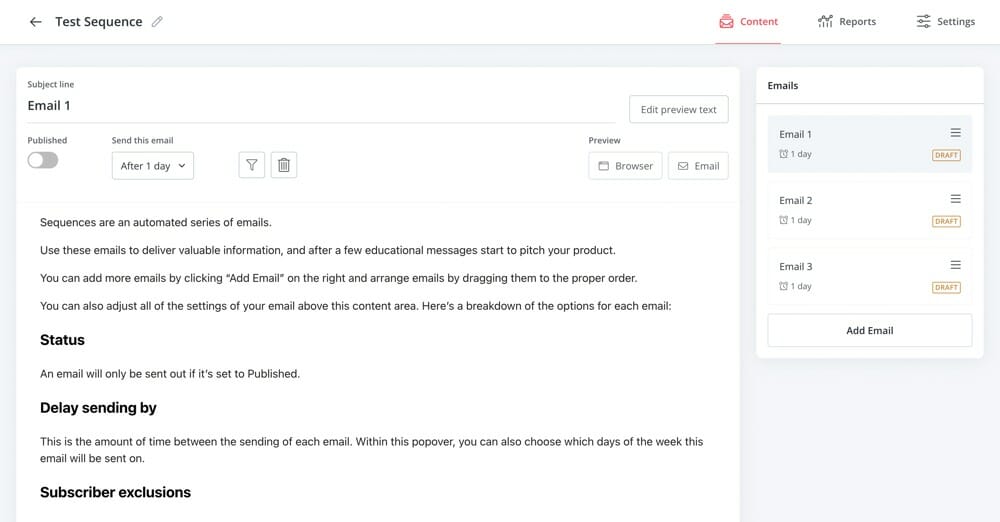
You can view and edit the emails in the same window so the process is fluid and fast. Once again, the emails are basic but especially if you just want to create text-only emails it’s very effective.
While the sequence builder is great for basic email drip sequences, for any more customized automations or advanced email marketing campaigns you’ll need to head over to the automation builder.

ConvertKit’s visual automation builder is quick and simple to use. As a beginner you could jump in and start building out basic automations very easily. However, the automations are much more limited than ActiveCampaign in terms of actions and triggers.
ConvertKit has only four start triggers whereas ActiveCampaign has over twenty. CK’s four triggers are: joins a form, is added to a tag, purchase or custom field.
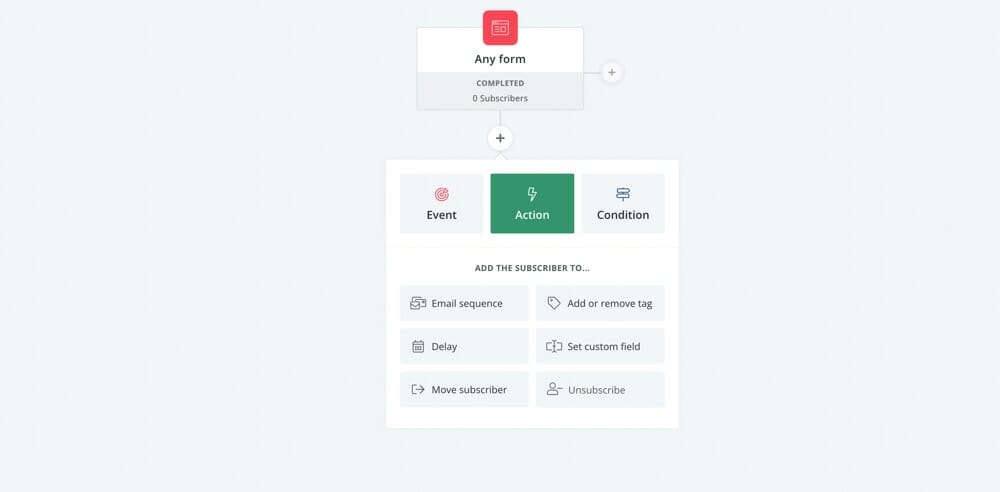
It also doesn’t support some of the more advanced marketing automation features. For example, you can’t create automations without a trigger which can become a limitation once you start building out more advanced workflows.
Plus you’ll need to use manual workarounds for some more complex tasks such as setting a goal or for users re-entering a sequence.
There are nearly 30 automation templates for things like welcoming subscribers to your list, abandoned carts and evergreen newsletters.

You can easily see what automations a contact is in but not where in the automation they are.
Keep in mind that the visual automation funnels and sequences are only available on the Creator Plan or higher.
You can learn more about ConvertKit’s marketing automation builder here.

ActiveCampaign Marketing Automation Review
Unlike ConvertKit, sequences and automated emails are created using the same builder inside ActiveCampaign. So everything from super basic automations up to the most advanced ones are built out in the same section using the same tools.
This means ActiveCampaign isn’t as quick as ConvertKit to build more simple workflows but that’s not surprising given how many extra features it has. Building out a sequence can take a bit more time but you can end up with much more customized emails and workflows if that’s what you want.
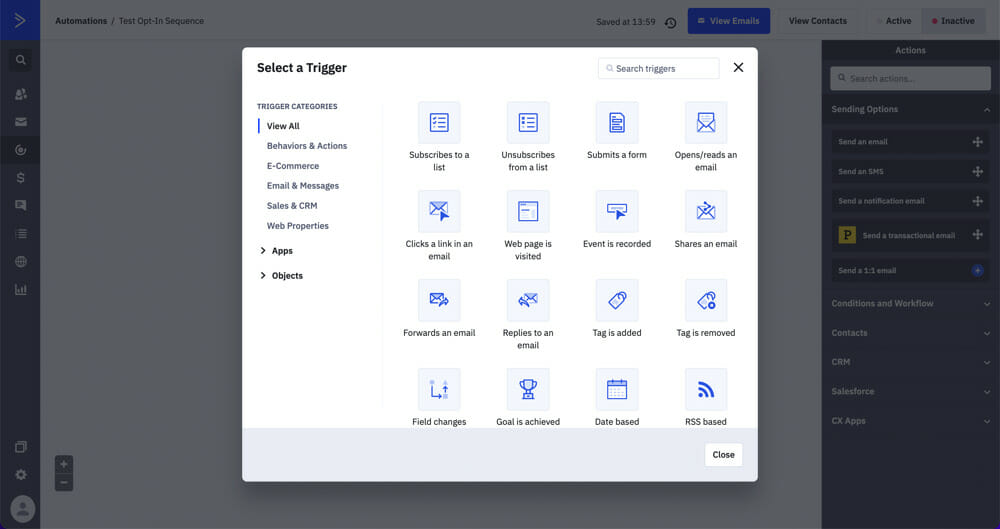
Advanced automation is where the full power of ActiveCampaign comes in. You have so many options and capabilities. The sky’s the limit when it comes to building out workflows and complex marketing campaigns.
There’s a full library of automations with around 40 actions and over 20 triggers. This is a massive step up from ConvertKit.
One super useful feature is the Goal action. This allows you to jump a user forward in a workflow once they’ve hit a particular goal or meet a certain criteria.
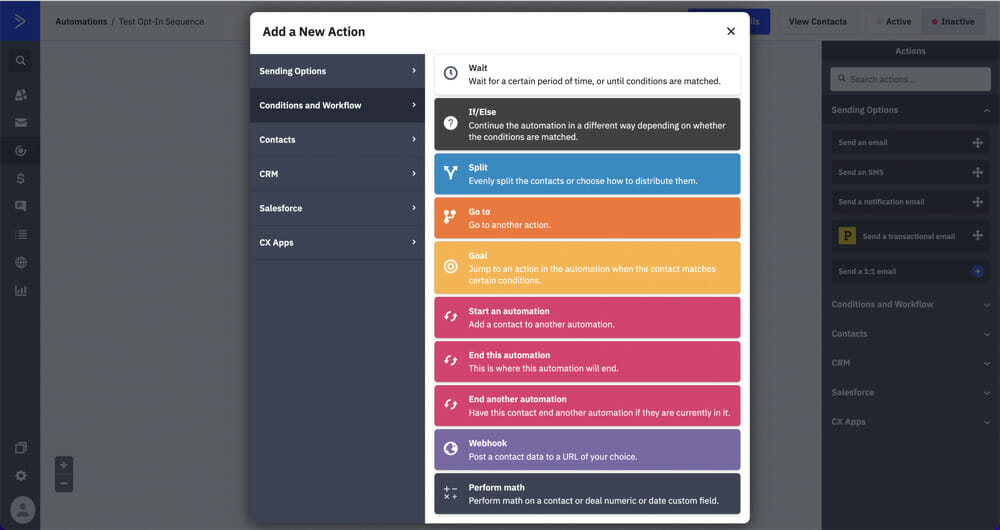
For example, say you have a user in a sequence and you want them to click a link over the course of four emails. If they click on that link in the first, second or third email, the Goal action will push them forward in the automation so they don’t receive any more emails trying to get them to click the link again. This is an awesome tool to have.
You can start automations without a trigger. This is useful if you want to manually add individual contacts or if you only want contacts to enter the automation after completing a different automation.
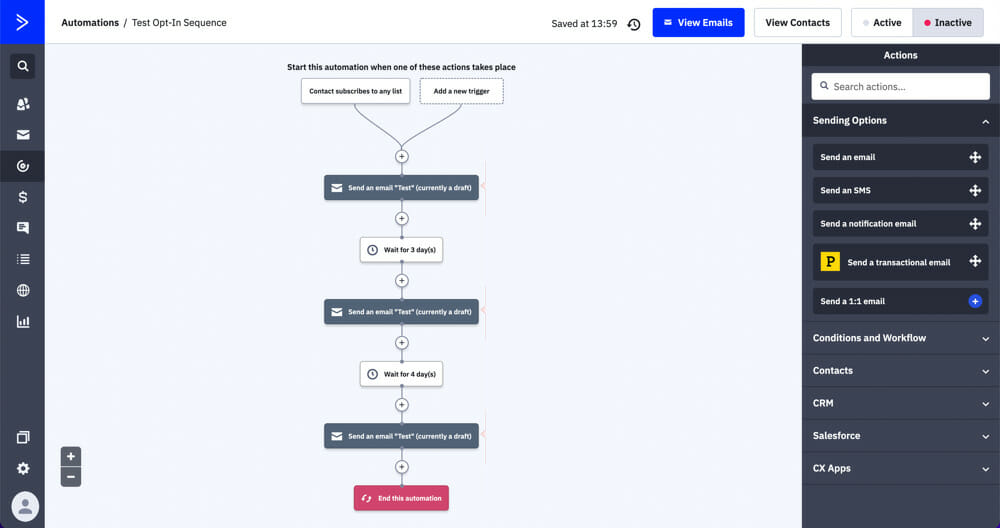
There’s also a huge range of conditions available when segmenting your contacts in the automations.
You can go down to specific actions a user has performed such as ‘has clicked a link’, ‘has not clicked a link’, ‘has visited a page’, etc. There’s a ton of options.
There are around 25 automation templates for things like upselling, ecourse delivery and failed billing reminders.
Learn more about ActiveCampaign’s marketing automation tools here.

The Verdict
ActiveCampaign is incredibly powerful for email automation. It’s hands down one of the most impressive platforms when it comes to advanced marketing automation features.
If you’re not going to be using advanced automation tools then ConvertKit has enough basic features to get the job done.
Segmentation Comparison
Contact segmentation is incredibly important. It allows you to group your contacts and only send particular emails to the people who are most likely to be interested in them.
Different email marketing services use a range of different segmentation tools. We’ll dive into what combination of tools are used by each email marketing software and analyze how granular these allow you to get with your segmentation.
ConvertKit Segmentation Review
ConvertKit utilizes tags, segments and custom fields for contact segmentation. Tags are applied to individual contacts, segments are groups of tags and custom fields allow you to store additional information about your contacts.
The custom fields are a bit limited. There’s not a separate area to manage them – this can only be done inside a contact’s profile.
Additionally, all custom field data is plain text. This means even though you’re able to insert dates into a custom field, they won’t be detected as dates. So using custom field data with date-based logic in automations isn’t possible.
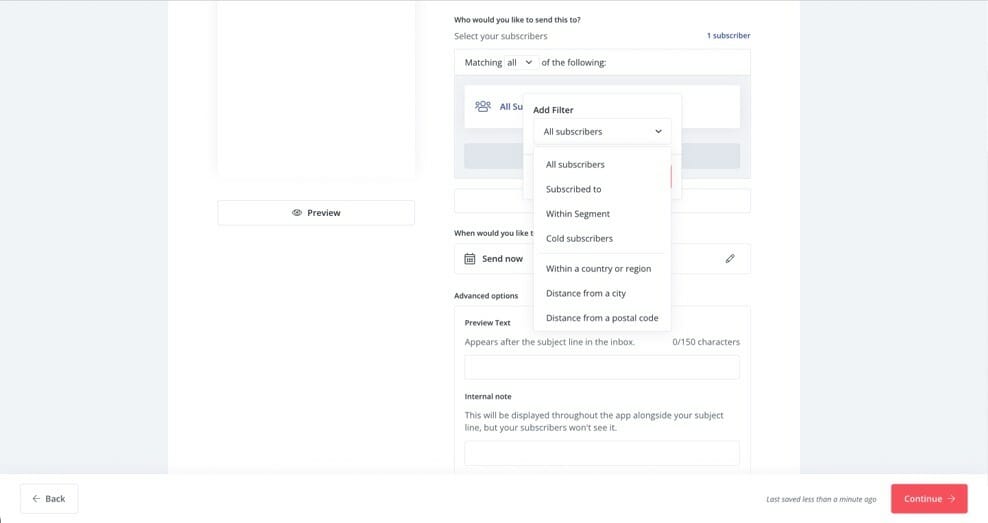
The in-built filters for segments are limited and some seem a bit pointless e.g. distance from a city, distance from a postal code and email address.
It’s also worth noting that relying on tags to track and segment your subscribers in an email marketing software can get a little messy. You will eventually end up with a massive number of tags.
You can learn more about how ConvertKit utilises tags for segmentation here.
Overall, these features are flexible enough for decent contact segmentation and allow you to get specific with which contacts are receiving which email campaigns.
ActiveCampaign Segmentation Review
In ActiveCampaign you can use lists, tags and custom fields to segment your audience. Relying on lists rather than tags (like ConvertKit) can make segmentation cleaner and less clunky.
The custom fields can be managed in a separate section and each custom field must belong to a field group. This is really powerful as you can add multiple custom fields into each field group, allowing you to get really granular with your segmentation.
ActiveCampaign’s custom fields also support more flexible data types (e.g. dates). All of this makes the custom field feature much more powerful in ActiveCampaign than ConvertKit.
All of these tools make segmenting your contacts really easy. They also make it easy for contacts to subscribe and unsubscribe from different lists based on the type of email they want to receive.

While you can replicate this same kind of workflow with ConvertKit using tags, it does require manual workarounds. You’d need to set up custom rules to remove from tags and add to tags which can be a little painful.
Being able to utilize all of these tools to this level gives you a lot of flexibility and is really powerful.
The Verdict
ActiveCampaign’s tools are more advanced and allow for more streamlined segmentation than ConvertKit.
Contacts Comparison
Some email marketing software have built-in customer relationship management (CRM) tools that allow you to completely manage your customers from within your email platform. Others have very basic contact information and require you to have a third party CRM system.
We’ll take a look at the key features each email marketing service provides for contact management.
ConvertKit Contacts Review
Basic contact management is available. There isn’t a recent activity feed, but you can view a contact’s email history, automations, sequences, forms, purchases and tags.
As mentioned earlier, you can add custom fields for users but this is limited to plain text.
Contact scoring (the method of ranking your contacts based on where in the customer journey they are) can only be accessed on the Creator Pro Plan. Exclusions are supported but only using tags.
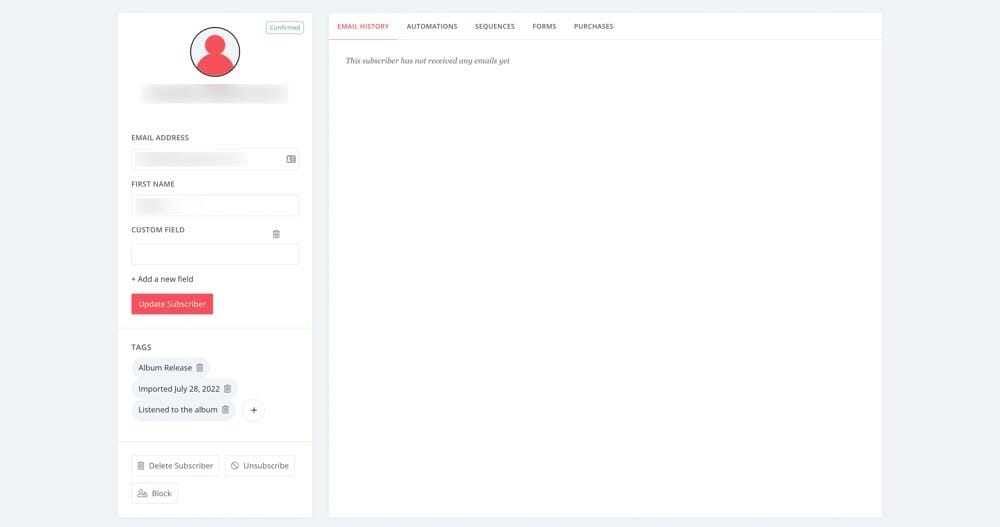
ActiveCampaign Contacts Review
Being a CRM as well as an email marketing platform, ActiveCampaign gives you a lot more customer information than most of the other email marketing platforms. You’re able to get a really comprehensive picture of your audience.
The recent activity feed has a high level of detail including when a contact has entered and completed an automation.
You can manually enter a contact into a list or automation directly from their contact page. You can also email individual contacts, add contact tasks and manage conversations.
As mentioned in the Segmentation section above, custom fields aren’t limited to plain text which adds another level of flexibility.
Contact scoring and exclusions are also supported.

The Verdict
ActiveCampaign offers much more comprehensive contact management than ConvertKit. These tools are really useful to have inside your email marketing software as it means you don’t need an additional CRM tool.
A/B Testing Comparison
A/B testing (also known as split testing) is a super powerful tool that allows you to really optimize your content.
Depending on the email marketing service, you could be able to test everything from email subject and content through to send time and sender address. Some tools even allow you to test your email automation workflows.
If you ask us, the more advanced testing available, the better. It’s awesome to be able to know you’re sending out the most popular version of your email.
ConvertKit A/B Testing Review
Only subject lines for broadcasts can be tested in ConvertKit. You can test two subject lines for each broadcast. Each subject is sent to 15% of recipients and after four hours the remaining emails are sent to the subject with the highest open rate.
After testing you can view insights into the open rate and click rate.
This level of testing leaves a lot to be desired, especially when compared to ActiveCampaign’s features.
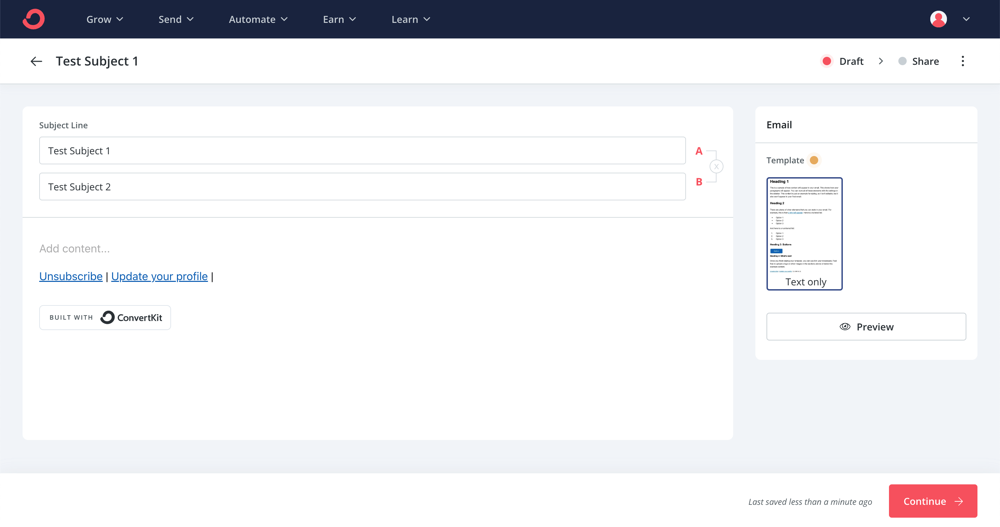
ActiveCampaign A/B Testing Review
You can test the subject line, sender name, content and images for broadcasts and sequences.
Up to five variables can be tested at once. There’s the option to run the test purely for analytics or you can auto-send to the best performer. The tests can be based on the best click through rate or best open rate.

You can even decide your own custom testing and sending ratios. This means you’re able to choose what percentage of your audience will receive each of the test emails.
For example, if you’re testing three different subjects for an email you might send each subject to 10% of the email list. You might decide to wait 5 hours and then send the email subject that has the best open rate to the remaining 70%.
This is a really powerful tool that allows you to make sure you’re sending the email content that’s most likely to get results.
However, currently the broadcast testing feature is only available when using the Classic and HTML editors.
ActiveCampaign also supports split testing automation workflows on their Professional Plan. This gives you the ability to test just about anything: wait times, number of emails, sales team follow ups, etc.
This means you can be really creative with your tests and find the workflow that will get the best outcome for your business.

The Verdict
ActiveCampaign offers really extensive testing options. These allow you to optimize your emails and workflows for the best results.
ConvertKit’s testing functions are extremely basic. It’s positive that you can split test titles and auto-send to the best performer, but this doesn’t allow you to optimize your results in the same way that ActiveCampaign does.
Forms & Landing Pages Comparison
Utilizing landing pages in your marketing campaign is a great way to build your email list AND your business. There are a number of aspects to consider such as the landing page templates, the landing page builder and the signup forms you can use within the page or on your website.
ConvertKit Forms & Landing Pages Review
Like their email builder, ConvertKit’s landing page builder is very easy to use but it’s also very limited. There’s no drag and drop builder and customization options are restricted.

There are over 50 modern, high quality templates for things like events, ebooks, products and webinars. Even though you don’t have many customization options, there’s a good chance you’ll find something close to what you want.
There’s no option to build landing pages from scratch.
In terms of forms, they support inline, pop-up, slide in and sticky bars. There are nine form templates to choose from.

ActiveCampaign Forms & Landing Pages Review
The ActiveCampaign landing page builder allows a really good level of flexibility. There’s a drag and drop editor that allows you to move things around easily. Everything is fully customizable. There’s a start from scratch option if you want to build out your own design.
This is completely different to ConvertKit’s builder which offers extremely little customization. It does feel a little bit clunky at times but you’ll definitely be able to build out some decent landing pages.
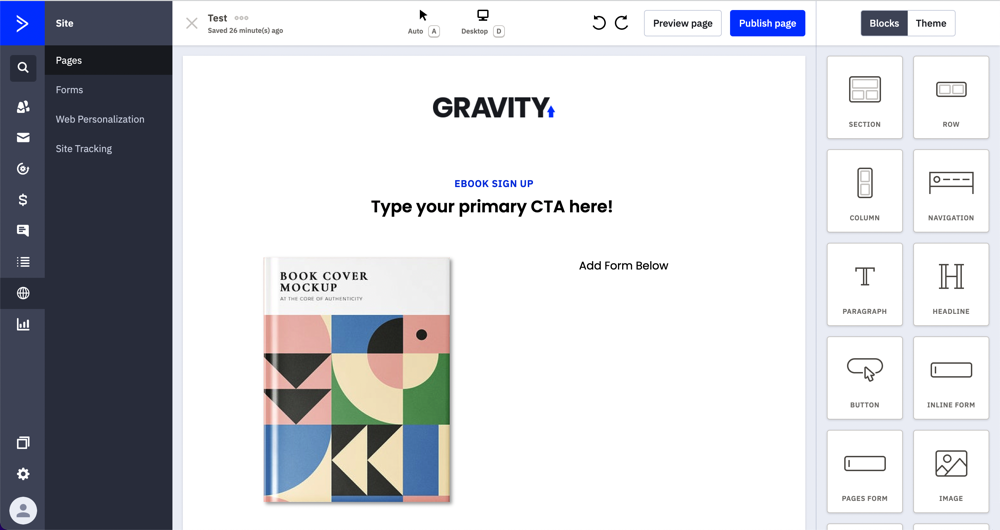
There are over 60 templates available, some of which look outdated. In comparison, ConvertKit’s landing page templates are much more modern and visually appealing.
ActiveCampaign supports inline, pop-up, floating box and floating bar forms that can be built in a separate form builder.
There are no form templates, just a very basic drag and drop form builder. It’s hard to build out something nice using this form builder. You’d probably want to link these forms to other opt-ins so they won’t be seen by users.
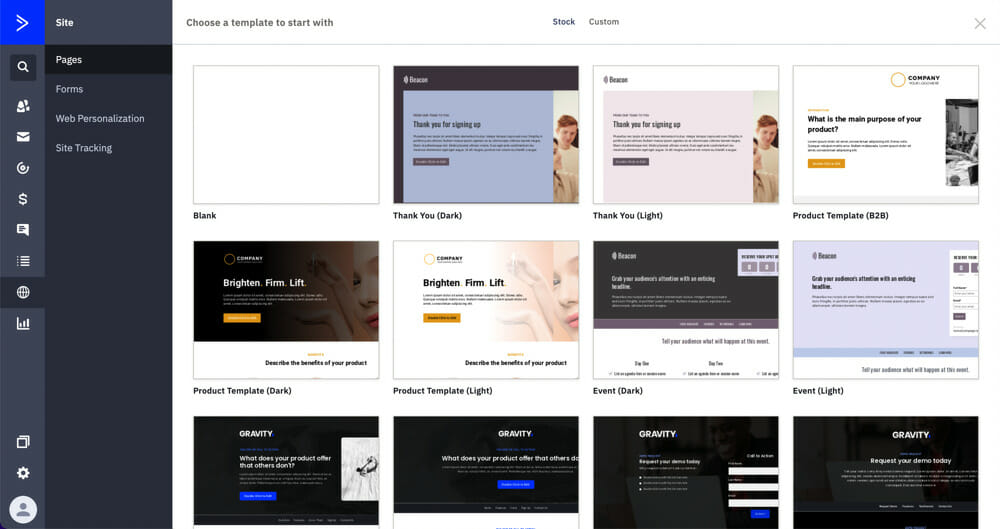
The Verdict
ActiveCampaign offers much more customization but ConvertKit has higher quality templates.
This one comes down to whether you want to have flexibility to build out your own landing pages or the ability to make basic changes and be done.
Ecommerce Comparison
If you’re an online or ecommerce business, ecommerce features are important! You’ll find that some email marketing platforms support a ton of built-in ecommerce tools and with others you’ll need to rely on integrations.
The right option for you will depend on your particular situation.
For example, if you’re after basic ecommerce tools you’d be able to depend on the built-in options. Whereas if you require advanced ecommerce support, you’re more likely to find what you need by using an external ecommerce provider.
ConvertKit Ecommerce Review
There are some great ecommerce features within ConvertKit. You can sell products directly through ConvertKit Commerce or you can link to your existing store via integrations.
You can sell ebooks, paid newsletters, courses, subscriptions, music, presets, coaching, etc.

The ecommerce features integrate really well with other tools. You can create product sales pages, check out pages, confirmation & transactional emails. They can easily be added to your broadcasts and automations as well.
There is a 3.5% fee plus 30c per transaction using ConvertKit Commerce on all of their pricing plans.
Click here to learn more about ConvertKit’s ecommerce features.
ActiveCampaign Ecommerce Review
ActiveCampaign doesn’t support ecommerce out of the box. However, it does integrate with other ecommerce platforms quite strongly.
This means if you already have an existing online store (though Shopify or WooCommerce, for example) then you can bring in that sales and customer data, and incorporate it into your automations.
While ConvertKit does have built-in ecommerce, it is quite restrictive. So if you want more advanced or customized ecommerce, you’d be better off using ActiveCampaign in conjunction with a more professional external ecommerce provider.
This method would be especially powerful if you have access to the Ecommerce dashboard which is available on the Plus Plan and higher. It provides metrics on where your subscribers are in the customer journey and insights into how you can increase sales. The dashboard integrates with BigCommerce, Shopify, WooCommerce, Magento and Square.
On top of that, it seems like ActiveCampaign is prioritizing the addition of more built-in ecommerce features as well.
They’ve announced that an ecommerce product block will be released for the Email Builder. This will display product recommendations in emails based on user behavior (e.g. previous browsing or purchase history).
The ability to send transactional emails via Postmark through the automation builder has also recently been added.

The Verdict
ConvertKit has plenty of built-in ecommerce features while ActiveCampaign requires more integrations. ActiveCampaign’s strength lies in the metrics and insights it offers. Both are solid options for e-commerce businesses depending on your specific needs.
This one comes down to what kind of ecommerce features you require from your email marketing software.
Integrations Comparison
Having a solid number of direct integrations inside your email marketing platform allows you to access a ton of functionalities that aren’t built-in to the software. This is really powerful.
Some email marketing software rely on Zapier for their integrations rather than having native or direct ones. We always keep an eye out for this as native integrations are more seamless and easier to manage.
ConvertKit Integrations Review
There are 19 native integrations including Squarespace, Teachable, Shopify, WooCommerce, LeadPages and Zapier. There are plenty of ecommerce integrations but you might need to rely on Zapier for other things.
You can check out the full list of ConvertKit’s integrations to see if they offer what you need.
ActiveCampaign Integrations Review
There’s around 70 native integrations including Bonjoro, Facebook, Google Calendar & Analytics, PayPal, Shopify and Survey Monkey. You won’t need to rely on Zapier but it’s good to know it’s there for anything that ActiveCampaign doesn’t support.
You can browse through the complete ActiveCampaign integrations list here.
The Verdict
ActiveCampaign offers a ton more direct integrations than ConvertKit.
Reporting & Analytics Comparison
Having access to reporting and analytics from your email marketing campaigns allows you to analyze your results and hopefully improve on your next one.
The level of reporting you require really comes down to personal preference. For most people, basic reporting will tell you everything you need to know. But if you’re a numbers person, it’s great to have access to more advanced analytics.
ConvertKit Reporting & Analytics Review
When you first log in to ConvertKit, you’ll see a great summary of the headline statistics. As a beginner, it gives you everything you need. It shows you the health of your email list at a glance.
While it is very basic reporting, this is all a lot of users will need at a basic level. It’s accessible and super easy to use.
However, if you want access to some more advanced reporting, you won’t find much. You can only access information on open rates, click through rates and unsubscribes.
If you do want to view more advanced deliverability reporting, you can jump on the Creator Pro Plan to access this data. But CK’s advanced reporting feature still doesn’t top the high level of ActiveCampaign’s reporting that’s available on their Plus Plan.

*Screenshot of ConvertKit’s dashboard report taken from ConvertKit’s website
ActiveCampaign Reporting & Analytics Review
There’s an incredible amount of advanced reporting available inside ActiveCampaign.
For each email you can access forwards, bounce rates, hourly open trend graphs and more.
Automation reporting, which is available even on the Lite Plan, allows you to see a ton of data on your automations.
This includes how many contacts have entered the automation, the total sends, unique opens, total unsubscribes, etc. over a specified period of time. This allows you to really quickly measure the effectiveness of your automations at a glance.
You can also get analytics on campaigns, goals, contacts, deals and chat conversations.
Plus if you want to get even more specific, you can create custom reports on the Enterprise Plan.
This level of reporting allows you to really comprehensively measure the effectiveness of your email marketing strategy.
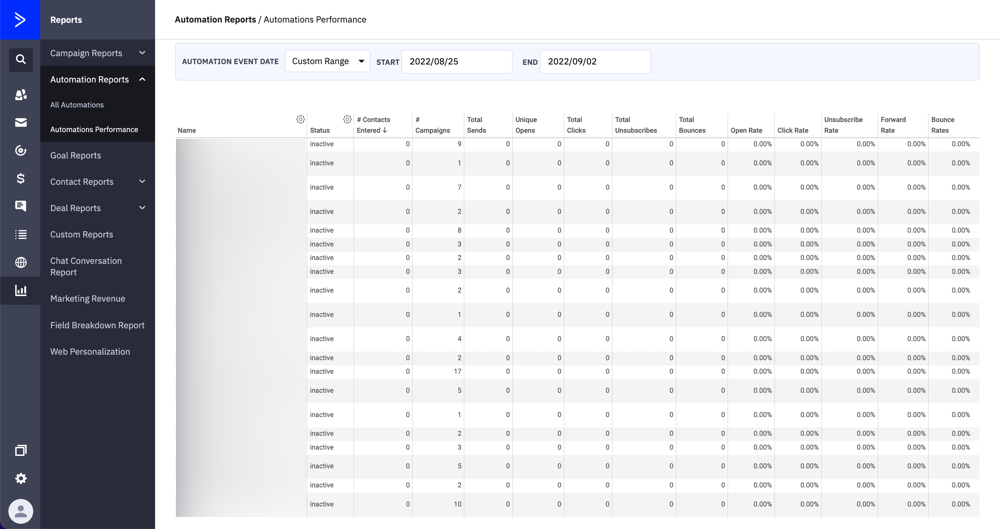
The Verdict
ConvertKit gives you the basics in a really easy to view format. If reporting isn’t important to you, this will definitely get the job done.
ActiveCampaign offers much more comprehensive reporting, so if you do want access to more detail then AC would be a better pick.
This comes down to what level of reporting you want access to.
Deliverability Comparison
Email deliverability is the number of emails that actually make it into your subscribers inbox. The emails you send can sometimes end up in the spam folder or simply not arrive at all.
Some email marketing software have higher email delivery rates than others. It’s a difficult thing to accurately assess and it’s constantly changing. We’re relying on what we deem a reliable source for this data: emaildeliverabilityreport.com.
ConvertKit Deliverability Review
According to Email Deliverability Report’s ConvertKit report, the average delivery rate is 82.89%, with 13.50% going to spam and 3.61% not reaching the recipient.
ActiveCampaign Deliverability Review
According to Email Deliverability Report’s ActiveCampaign report, the average delivery rate is 86.67%, with 10.61% going to spam and 2.73% not reaching the recipient.
The Verdict
Like we mentioned earlier, this is ever-changing and hard to measure but currently Email Report Deliverability ranks ActiveCampaign higher for deliverability. ConvertKit still has a solid deliverability rate that’s higher than a number of other email marketing software.
Other Noteworthy Features
There are some other noteworthy key features and marketing tools that don’t fit into the usual categories.
Non-Email Communications
Web push notifications are notifications that can be automatically sent to a user’s web browser after they’ve subscribed and given permission.
ActiveCampaign provides access to this feature via integrations.
It also directly supports website live chat and SMS marketing. SMS marketing is only available on the Plus Plan or higher.
ConvertKit doesn’t support any of these features at this point.
Learn more about ActiveCampaign’s website live chat and SMS marketing features.
Tracking
Site tracking is a super powerful tool that collects user activity across your web pages. This means you can get insight into what contacts are doing on your website and create personalized experiences for individuals based on how they interact.
Custom events are another way to track your user’s activity and market to them accordingly. They’re actions taken by users on your site. You’ll see an activity feed of user’s events and can trigger workflows when certain events occur.
ActiveCampaign offers both site tracking and custom event tracking while ConvertKit supports neither.
This could be a deal breaker for ConvertKit. These tracking features are game changers when it comes to automating your customer journey and creating personalized email marketing campaigns.
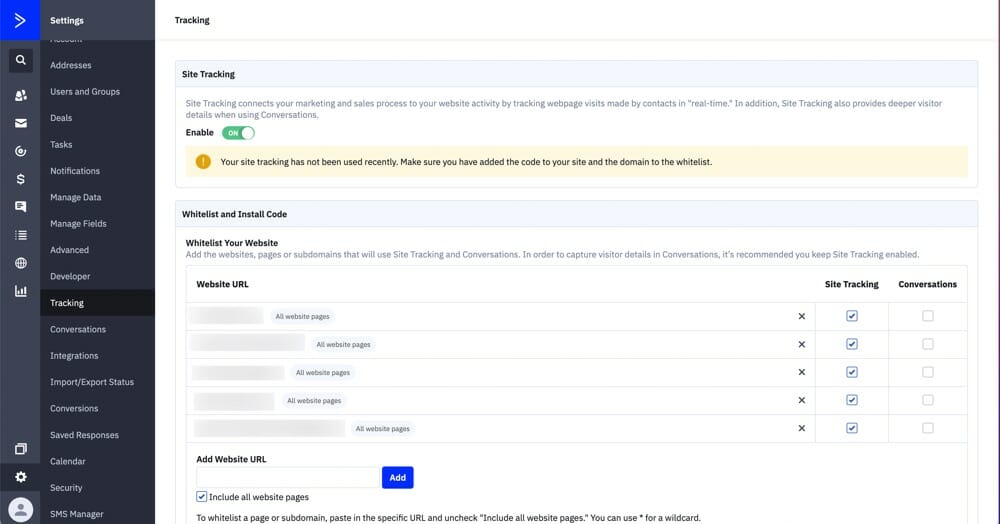
The Verdict
ActiveCampaign comes out ahead again.
If you’re just getting started or aren’t interested in more advanced automation tools, you’d be able to get by with ConvertKit.
Customer Support
This is another important aspect of choosing an email marketing software. If something goes wrong, it’s good to know whether customer support will be there to help.
We’ll also cover whether the platforms offer migration, a community and a knowledge base to help you find your way around the software.
ConvertKit Customer Support Review
Customer support is available 24/7 via live chat or email.
There’s free migration for users with over 5,000 subscribers on the Creator Plan or higher. It’s a full migration including lists, tags, forms, sequences, templates and automations.
They have a rating of 3/5 stars from a small number of reviews on Trustpilot. About half the reviews are positive while the other half claim to have had their accounts locked or closed for multiple days with slow response times from support as to why.
It’s worth mentioning that this locked or closed account issue is likely due to the need for manual approval when setting up a new account. There’s low risk of this happening once you’re live in CK.
There’s an active ConvertKit community but responses are often from staff. The answers are usually to email support or to read an article but it’s good to have that interactive community there. The response times in the community are generally within a couple of days.
There are also blog articles, video trainings and a massive knowledge base of tutorials that outline how to do pretty much everything in ConvertKit.
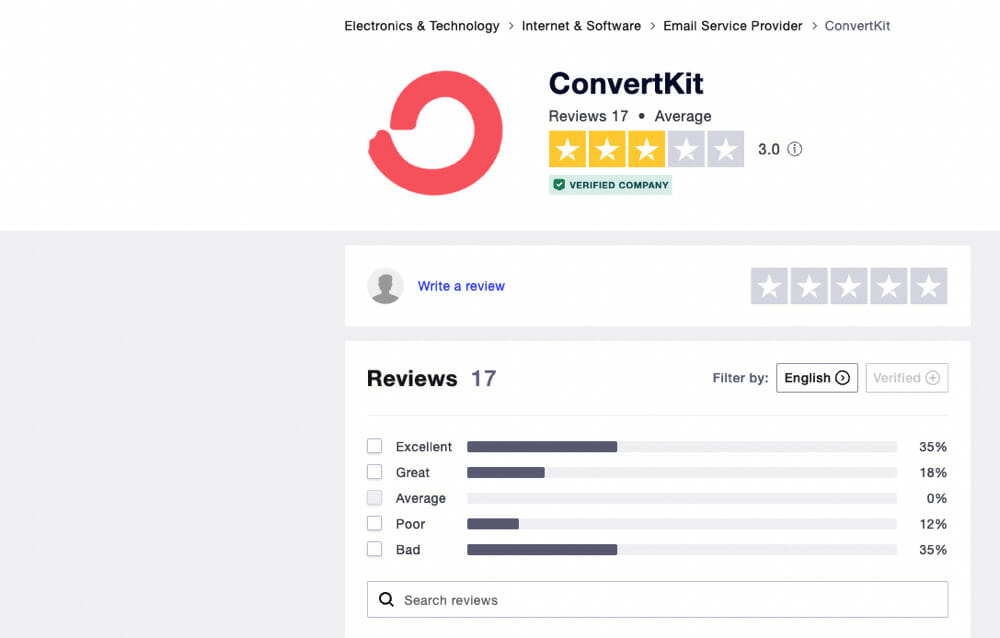
ActiveCampaign Customer Support Review
Live chat is available Monday – Thursday from 9am – 11pm and Friday from 9am – 4:30pm, CST. You can also request help via support ticket, email and if you’re on the Enterprise Plan via phone.
They offer free migration for any number of subscribers. The migration includes automations, email templates, forms, landing pages, lists, tags and custom fields.
Very shortly after signing up you’ll receive a phone call plus an email from ActiveCampaign offering a free one on one call to help you get started as well as a demo video with some easy steps to get set up.
They have a 4/5 star rating from a large number reviews on Trustpilot. Over 65% rated them 5 stars. In terms of customer service, the majority of users report great support while a handful complain of slow wait times or inadequate responses.
There is an ActiveCampaign community but it isn’t overly active. Some of the questions are years old and haven’t been answered.
Thankfully there are loads of educational articles on the website which will answer most of the questions you’d need answers to.
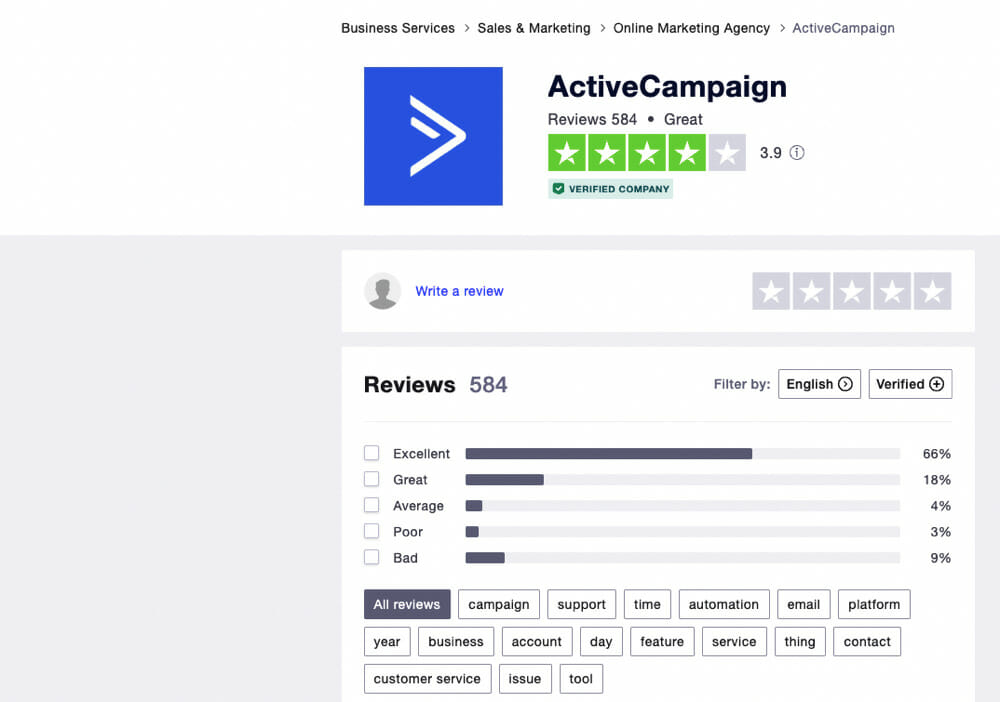
The Verdict
Both platforms offer solid customer support features. ActiveCampaign really goes above and beyond to make sure you’re settling in and learning the ropes. Not to mention they rate significantly higher than ConvertKit on Trustpilot.
ActiveCampaign wins this round.
Ease Of Use Comparison
Taking into account the ease of use of an email marketing software means there won’t be any nasty surprises when you jump in.
The last thing you want is to open up the platform only to realize there’s a massive learning curve and it’ll take hours to get up to speed (unless that’s something you were aware of!).
We’ve rated four common tasks on how easy they are to complete using each email marketing software.
ConvertKit Ease Of Use
ConvertKit is a really intuitive and easy to use email marketing software. As a beginner you could jump in there and easily figure out where things are and how they work.
| Ease of Performing Key Tasks | Comments |
| Send a broadcast ⭐⭐⭐⭐ | Sending a broadcast is really straightforward. For text-only emails, it’s as quick and simple as typing out your email and sending or scheduling it. For visual emails, it’s also really quick because of how basic the customization options are. |
| Setup basic automation ⭐⭐⭐⭐ | Basic automations like a simple opt-in series are very easy and quick to build out. The automation builder is snappy and intuitive. It’s awesome that you can edit emails within the same view – this makes the process feel more seamless and fast. |
| Setup complex automation ⭐⭐ | More advanced automations are either limited or take a bit of extra time to build out manual workarounds. |
| Manage contacts ⭐⭐⭐ | Some of the functionalities are a bit limited but it’s easy to perform the actions that are available. |
ActiveCampaign Ease Of Use
Because ActiveCampaign has so many advanced features, it’s not overly beginner-friendly. There’s understandably a bit of a learning curve to figure out how everything works. It’s not as intuitive as other email marketing services like ConvertKit.
| Ease of Performing Key Tasks | Comments |
| Send a broadcast ⭐⭐⭐ | Going through the steps to build out a broadcast is a bit more time consuming than ConvertKit. But it’s still straightforward and easy to jump into. |
| Setup basic automation ⭐⭐⭐⭐ | Building out basic automations is fast and user-friendly. It can be a bit quicker in less advanced software but the process is still straightforward. |
| Setup complex automation ⭐⭐⭐⭐ | This is super powerful but it can take a bit longer to get the hang of due to all the options and functionalities. The templates would come in handy if you’re just starting out. |
| Manage contacts ⭐⭐⭐⭐⭐ | There are a ton of CRM features making it really easy to manage your contacts. |
The Verdict
ConvertKit is easier to use for basic tasks. ActiveCampaign isn’t as easy to use for those basic tasks but it’s much more streamlined for any tasks that go beyond those basic ones.
It comes down to what you’ll be using your email marketing software for.
Pricing ($USD/monthly) Comparison
Of course, price is another significant factor when it comes to the right email marketing solution for your business.
It’s always useful if the software offers a free plan as well, but keep in mind that these are usually limited to less than 1,000 contacts and have a number of gated features.
ConvertKit Pricing
There’s a Free Plan available for under 1000 subscribers but this doesn’t include access to email sequences or the automation builder.
For most people, the Creator Plan is going to be what you need so you have access to those features.
You can check out the other pricing options to see which features they offer here.
Only one team member is allowed on the Creator Plan. If you need access for more users, you’ll need to jump on the Creator Pro Plan which allows an unlimited number of team members.
You can send unlimited emails on ConvertKit’s free and paid plans.
| Number of subscribers | 1,000 | 10,000 | 100,000 |
| Price ($USD/month) | $29 | $119 | $679 |
| When billed annually/month | $25 | $100 | $566 |
ActiveCampaign Pricing
There’s no free plan available with ActiveCampaign. The cheapest option for 1000 contacts is $29/month on the Lite Plan.
It’s important to note that ActiveCampaign recently updated their pricing model. Previously, an ActiveCampaign subscription included both email marketing and CRM related tools.
Now, these tools have been divided into two different suites:
- ActiveCampaign for Marketing – Email Marketing & Automations
- ActiveCampaign for Sales – CRM & Sales Automation
This means that if you want to utilize ActiveCampaign’s email marketing and CRM features, you will need to purchase a bundle of both plans. This makes ActiveCampaign quite an expensive option.
To get access to all the super powerful email marketing tools such as CRM features, landing pages and conditional content, we’d recommend the Plus Plan bundle. You can check out the pricing for this bundle in the table below.
Find out which plan offers the features you need here.
Up to five users are allowed on the Plus Plan.
You can send unlimited emails on all plans until you reach 300,000 email subscribers (then the limit becomes 10x your subscriber list).
| Number of subscribers | 1,000 | 10,000 | 100,000 |
| Price ($USD/month) | $116 | $333 | $1,145 |
| When billed annually/month | $92 | $266 | $916 |
Reviewer’s Recommendation: Which One Has The Best Email Marketing Tools?
As you can tell, ConvertKit and ActiveCampaign each have their own pros and cons. Both are solid email marketing platforms that are capable of running successful email marketing campaigns.
You could comfortably grow a large or small business using either of these services. But when it comes down to choosing between ConvertKit vs ActiveCampaign, which one is better for you?
ConvertKit is a great email marketing platform for beginners. The interface is intuitive, making it easy to pick up and use.
If your focus is on quickly and easily sending basic emails, selling products directly through your email marketing software or jumping straight into a new platform with minimal learning curve, then ConvertKit might tick your boxes.
Sound like it could be right for you?
ActiveCampaign can be harder for beginners to get the hang of. But if your aim is to grow your business with email marketing, it’s worth investing the time to learn it.
If you want the ability to access advanced automations, CRM-related features, and reporting & testing functionalities, then ActiveCampaign might be the one for you.
Want to test it out?


